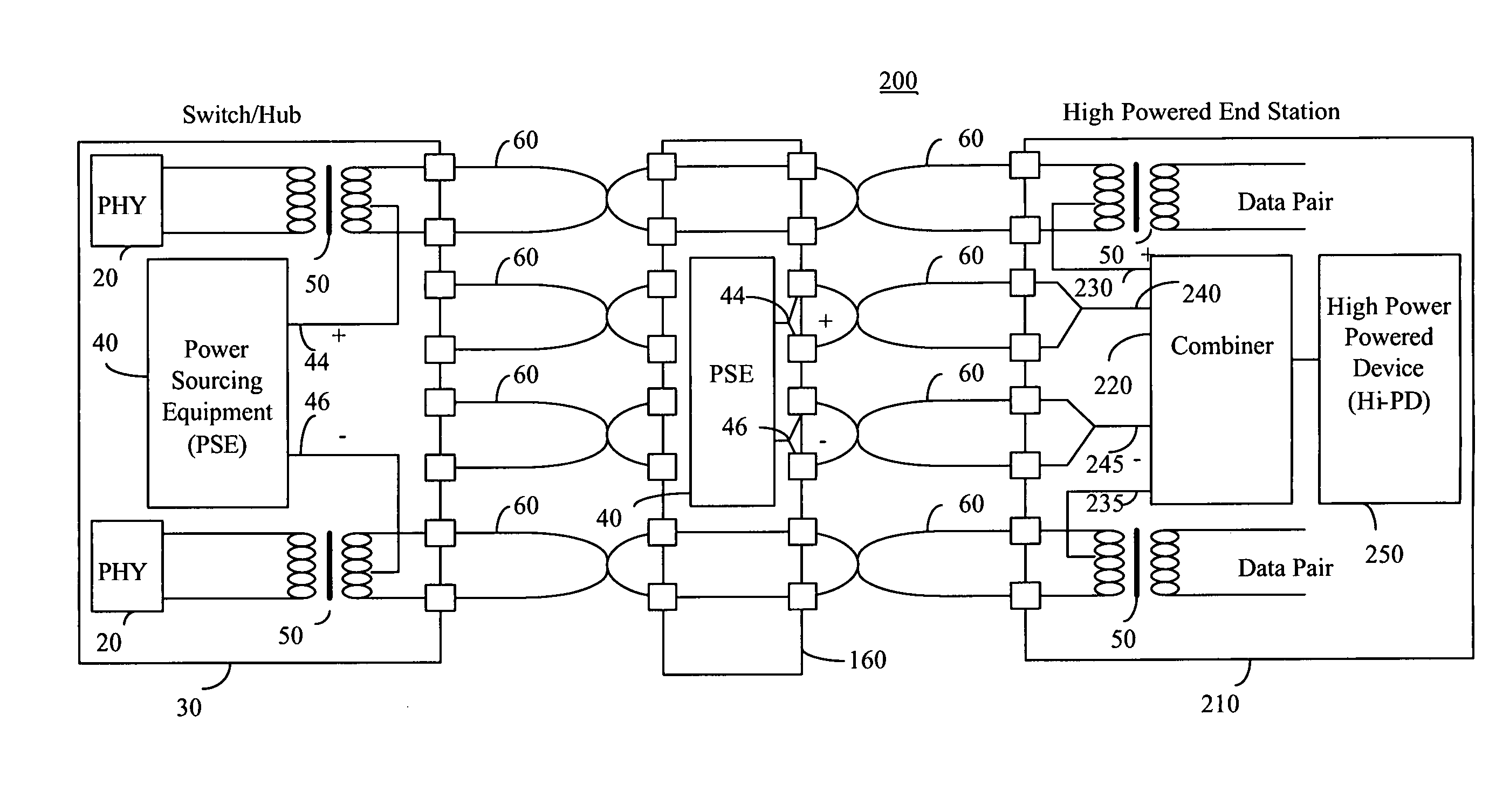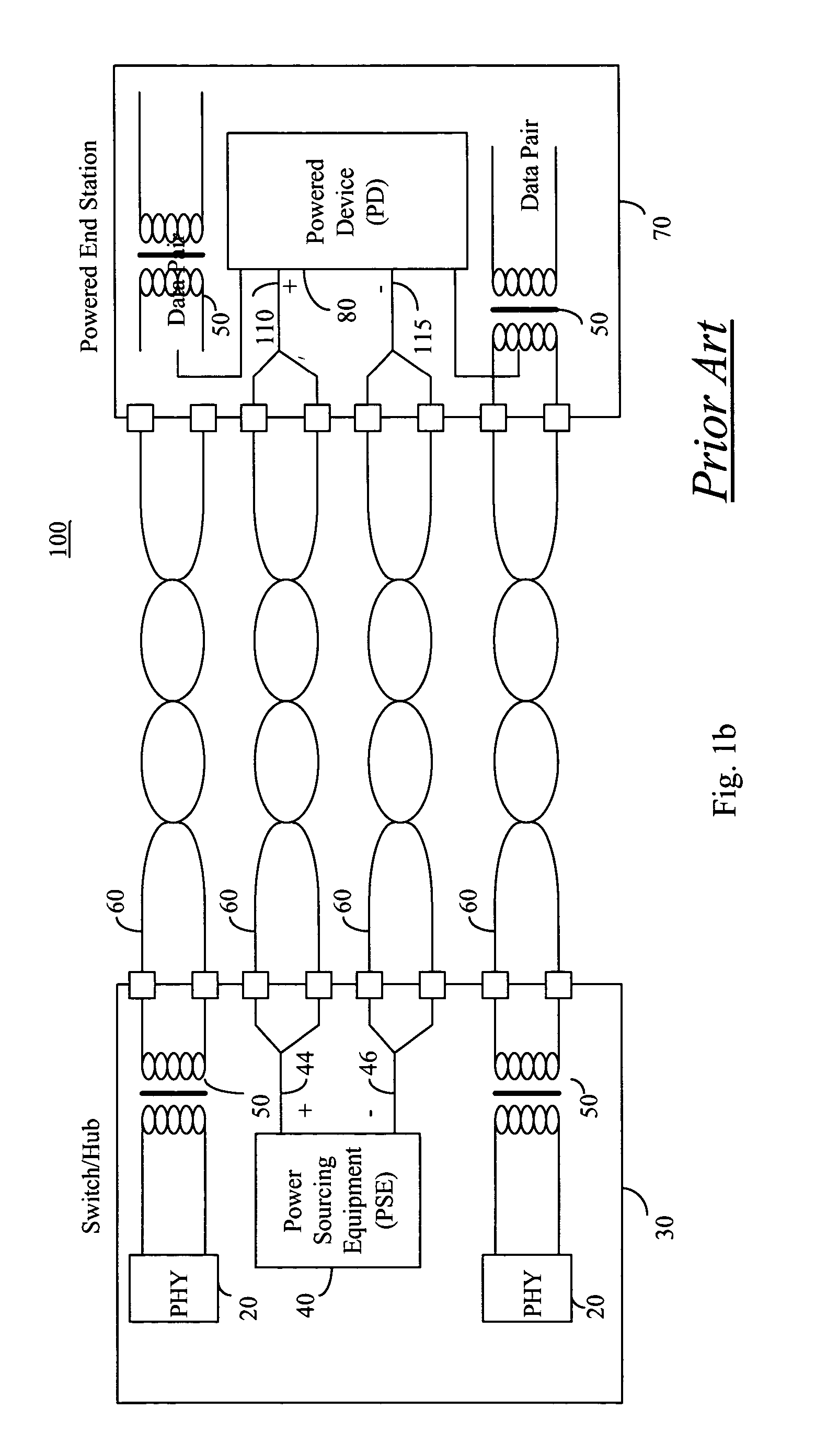High power architecture for power over Ethernet
a technology of ethernet and high power, applied in the field of power over local area networks, can solve the problems of no provision in the above standard, the above standard is limited to a powered device, etc., and achieve the effect of high power outpu
- Summary
- Abstract
- Description
- Claims
- Application Information
AI Technical Summary
Benefits of technology
Problems solved by technology
Method used
Image
Examples
first embodiment
[0052]FIG. 2a illustrates a high level block diagram of a multiple path power feeding network configuration, herein designated network configuration 200, according to the principle of the invention. Network configuration 200 comprises: switch / hub equipment 30 comprising first and second PHY 20, first and second transformers 50 and endpoint PSE 40 having positive power output lead 44 and negative power output lead 46; first through eighth twisted pair connections 60; midspan power insertion equipment 160 comprising midspan PSE 40 having positive output lead 44 and negative power output lead 46; and high powered end station 210 comprising third and fourth transformers 50, power combiner 220 having first positive power input 230, first negative power input 235, second positive power input 240 and second negative power input 245 and high powered PD (Hi-PD) 250.
[0053] The primary of first and second transformers 50 are respectively connected to communication devices typically through fir...
second embodiment
[0058]FIG. 2b illustrates a high level block diagram of a multiple path power feeding network configuration, herein designated network configuration 300, according to the principle of the invention. Network configuration 300 comprises: high power switch / hub equipment 305 comprising first and second PHY 20, first and second transformers 50 and endpoint PSE 310 having a first power output comprising first positive power output lead 320 and first negative power output lead 325, a second power output comprising second positive power output lead 330 and second negative power output lead 335; first through fourth twisted pair connections 60; and high powered end station 210 comprising third and fourth transformers 50, power combiner 220 having first positive power input 230, first negative power input 235, second positive power input 240 and second negative power input 245 and high powered PD (Hi-PD) 250.
[0059] The primary of first and second transformers 50 are each connected to communic...
third embodiment
[0063]FIG. 2c illustrates a high level block diagram of a multiple path power feeding network configuration, herein designated network configuration 350, according to the principle of the invention. Network configuration 350 comprises: switch / hub equipment 35 comprising first and second PHY 20 and first and second transformers 50; first through eighth twisted pair connections 60; high power midspan power insertion equipment 360 comprising third and fourth transformers 50 and midspan PSE 310 having a first power output comprising first positive power output lead 320 and first negative power output lead 325, and further having a second power output comprising second positive power output lead 330 and second negative power output lead 335; and high powered end station 210 comprising fifth and sixth transformers 50, power combiner 220 having first positive power input 230, first negative power input 235, second positive power input 240 and second negative power input 245 and high powere...
PUM
 Login to View More
Login to View More Abstract
Description
Claims
Application Information
 Login to View More
Login to View More - R&D
- Intellectual Property
- Life Sciences
- Materials
- Tech Scout
- Unparalleled Data Quality
- Higher Quality Content
- 60% Fewer Hallucinations
Browse by: Latest US Patents, China's latest patents, Technical Efficacy Thesaurus, Application Domain, Technology Topic, Popular Technical Reports.
© 2025 PatSnap. All rights reserved.Legal|Privacy policy|Modern Slavery Act Transparency Statement|Sitemap|About US| Contact US: help@patsnap.com



